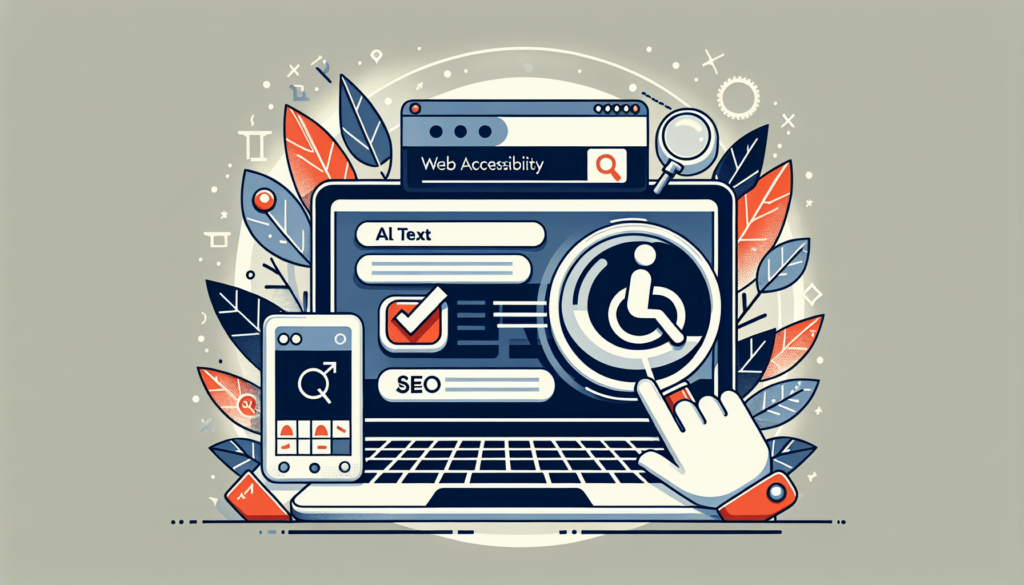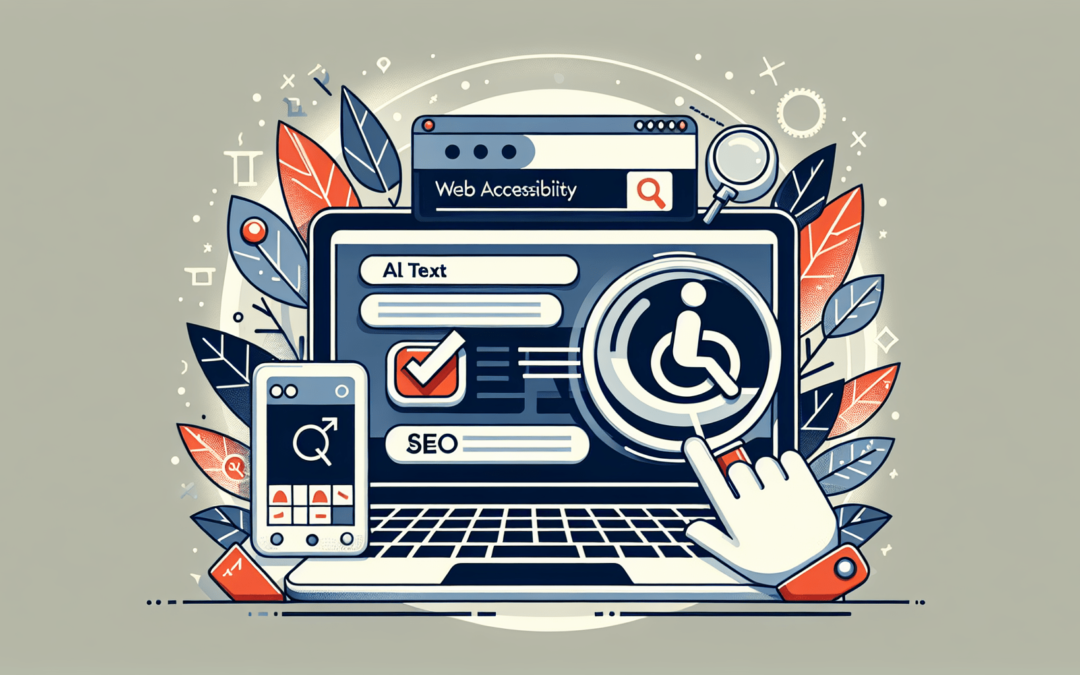In today’s digital landscape, ensuring that your website is accessible to all individuals is not only a legal and ethical obligation but also a crucial factor that impacts your search engine rankings. Understanding the correlation between accessibility compliance and search engine rankings opens up a world of opportunities for businesses to reach a wider audience, enhance user experience, and ultimately boost their online visibility. So, let’s explore how accessibility compliance can directly influence your search engine rankings and why it should be a top priority for your website.

Overview of Accessibility Compliance
Definition of Accessibility Compliance
Accessibility compliance refers to the adherence to certain guidelines and standards that ensure websites and digital content are accessible to all individuals, including those with disabilities. It involves making necessary modifications and providing alternative ways for people to consume and interact with online information, regardless of their physical or cognitive abilities.
Importance of Accessibility Compliance
Accessibility compliance is crucial as it promotes inclusivity and equal access to information for all users. By ensuring that websites are accessible, businesses and organizations can cater to a wider audience and ensure that individuals with disabilities can fully engage with their online content. It is not only ethically essential but also legally required in many jurisdictions.
Examples of Accessibility Compliance Standards
There are several widely recognized accessibility compliance standards that organizations can follow, such as the Web Content Accessibility Guidelines (WCAG) developed by the World Wide Web Consortium (W3C). These guidelines outline specific requirements, techniques, and best practices for creating accessible digital content. Other standards include Section 508 of the Rehabilitation Act in the United States and the European Union Web Accessibility Directive.
The Importance of Search Engine Rankings
Definition of Search Engine Rankings
Search engine rankings refer to the position a website holds in the search engine results pages (SERPs) for specific keywords or phrases. When users conduct a search, search engines like Google rank websites based on their relevancy, authority, and other factors to determine the order in which results are displayed.
Significance of High Search Engine Rankings
High search engine rankings are crucial for online visibility and exposure. Websites that appear at the top of the search results are more likely to receive clicks and organic traffic. Achieving a high ranking improves a website’s chances of attracting users, generating leads, and increasing conversions.
Factors Influencing Search Engine Rankings
Various factors influence search engine rankings, including website content, backlinks, site speed, user experience, and accessibility. Search engines aim to deliver the best possible results to users, so they value websites that offer high-quality, relevant information, and provide a positive user experience.
Accessibility as a Ranking Factor
Google’s Focus on User Experience
Google, the most popular search engine, places significant emphasis on user experience. It prioritizes websites that provide valuable and accessible content to all users, regardless of their disabilities. By prioritizing user experience, Google aims to deliver the most relevant and useful results to its users.
Google’s Guidelines on Accessibility
Google has provided guidelines on accessibility to help website owners create user-friendly and inclusive websites. These guidelines include technical recommendations for developers and content publishers and cover aspects such as accessible design, proper use of headings and alt text, keyboard navigation, and more.
Impact of Accessibility on User Experience
Accessibility greatly impacts user experience. By ensuring that websites are accessible to individuals with disabilities, they can navigate and consume content more easily. Furthermore, accessible websites are often more user-friendly for all users, leading to improved engagement, longer visit durations, and lower bounce rates. Google recognizes this correlation between accessibility and positive user experience, which can positively affect search engine rankings.

Web Accessibility Best Practices
Semantic HTML and Proper Structure
Using semantic HTML and maintaining proper website structure provides a strong foundation for accessibility. This involves using heading tags (H1, H2, etc.) correctly, organizing content with lists, and utilizing proper HTML elements for their intended purposes. Semantic HTML helps screen readers and other assistive technologies understand the page’s structure and enhances the overall user experience.
Alternative Text for Images
Providing alternative text, also known as alt text, for images is crucial for accessibility. Alt text serves as a textual description of images, allowing users with visual impairments to understand the content. Search engines also rely on alt text to comprehend images, which can contribute to improved search engine rankings.
Keyboard Navigation and Focus
Ensuring that websites can be accessed and navigated using a keyboard is vital for individuals with motor disabilities who cannot use a mouse. Proper focus management is essential, ensuring that users can easily distinguish the currently focused element when using keyboard navigation. Keyboard navigation is not only an accessibility requirement but also improves overall usability.
Color Contrast Compliance
Maintaining adequate color contrast between text and background is essential for individuals with visual impairments or color blindness. Websites should meet or exceed the WCAG color contrast guidelines, ensuring that text is legible and discernible for all users. Failing to comply with color contrast standards can result in reduced accessibility and potential penalty in search engine rankings.
Responsive Design and Mobile Accessibility
With the increasing number of users accessing websites on mobile devices, it is crucial to prioritize responsive design and mobile accessibility. Websites should be designed to adapt to various screen sizes and provide a seamless user experience on mobile devices. Responsive websites not only improve user experience but also cater to diverse user needs and contribute to higher search engine rankings.
Accessible Forms and Input
Creating accessible forms and input fields ensures that individuals with disabilities can engage with online forms and provide necessary information. Using proper field labels, providing clear instructions, and enabling error validation and clear error messaging are important aspects of accessible forms. By making forms accessible, businesses can enhance user experience and ensure compliance with accessibility standards.
Crawling and Indexing of Accessible Websites
Search Engine Bots and Accessibility
Search engine bots, also known as crawlers or spiders, are responsible for indexing webpages and determining their relevance to specific search queries. These bots navigate websites similarly to how humans do, scanning content and following links. Ensuring accessibility compliance helps search engine bots better understand and index webpages accurately.
How Search Engines Evaluate Accessibility
Search engines evaluate accessibility by analyzing the elements and structure of websites. They take into account factors such as semantic markup, alt text usage, color contrast, keyboard accessibility, and mobile responsiveness. Websites that meet accessibility standards are more likely to be seen as credible and valuable resources by search engines.
Benefits of Accessibility for Crawling and Indexing
Accessible websites have several benefits when it comes to crawling and indexing. By following accessibility best practices, website owners can improve the crawling and indexing process, ensuring that their content is accurately understood and categorized by search engines. Additionally, accessible websites are more likely to receive valuable backlinks and social shares, further enhancing their visibility in search engine results.
SEO Benefits of Accessibility Compliance
Improved Website Visibility
Accessibility compliance can improve website visibility by ensuring that all users have access to the content. With accessible websites ranking higher in search engine results, more users will discover and engage with the website, leading to increased visibility and exposure.
Increased Organic Traffic
As accessible websites are more likely to rank higher in search engine results, they attract increased organic traffic. Users are more likely to visit websites that appear at the top of search engine results, resulting in more website visits and potential conversions.
Enhanced User Engagement
Accessible websites provide an improved user experience, leading to increased engagement. Users will spend more time on websites that are easy to navigate and consume content, resulting in lower bounce rates and higher page views. This increased engagement signals to search engines that the website is valuable and relevant, positively impacting search engine rankings.
Better Conversion Rates
When websites are accessible, individuals with disabilities can more easily complete desired actions, such as making a purchase or filling out a form. By removing barriers and ensuring a smooth user experience, accessibility compliance can contribute to better conversion rates and increased revenue.
Positive Impact on Brand Reputation
Demonstrating a commitment to accessibility compliance is an excellent way for businesses to build a positive brand reputation. By prioritizing inclusivity and ensuring all users can access and engage with their website, businesses can showcase their values and attract a broader audience.
Reduced Legal Risk
Non-compliance with accessibility standards can expose businesses to legal risks, including lawsuits and penalties. By prioritizing accessibility compliance, businesses can mitigate legal risks, avoid potential litigation, and maintain a positive brand image.
Common Accessibility Issues and Remedies
Lack of Alternative Text
A common accessibility issue is the lack of alternative text or improperly written alt text for images. The remedy is to ensure every image has descriptive alternative text that conveys the information or context of the image concisely.
Insufficient Color Contrast
Another common issue is insufficient color contrast between text and background. The remedy is to test the color contrast using online tools or browser extensions, and adjust the colors to meet accessibility standards.
Inaccessible Forms and Captcha
Inaccessible forms and Captcha can create barriers for individuals with disabilities. The remedy is to design forms using accessible techniques, such as providing clear labels, error messaging, and using captcha alternatives that are accessible to everyone.
Incompatibility with Screen Readers
Websites that are not compatible with screen readers can exclude individuals with visual impairments. To remedy this, websites should be designed and tested to work seamlessly with popular screen readers, ensuring all content is accessible through auditory means.
Non-responsive Design
Non-responsive design presents challenges for users accessing websites on different devices. The remedy is to implement responsive design techniques, such as utilizing CSS media queries, flexible layouts, and fluid images, to ensure websites adapt and provide a user-friendly experience across various screen sizes.
Remedies for Accessibility Issues
To address accessibility issues effectively, conducting regular accessibility audits and assessments is crucial. Web developers and content creators should receive proper training on accessibility best practices and utilize tools and resources that help identify and remediate accessibility issues. Additionally, involving individuals with disabilities during the testing phase can provide valuable insights and ensure the website meets their needs.
Website Testing and Compliance Evaluation
Manual Testing vs. Automated Testing
Website testing for accessibility compliance can be done manually or using automated tools. Manual testing involves a thorough review of the website’s design, code, and content, ensuring it meets accessibility standards. Automated testing relies on tools that scan the website and flag potential accessibility issues. While automated testing can expedite the process, manual testing remains crucial for identifying nuanced accessibility problems.
Accessibility Evaluation Tools
Several accessibility evaluation tools are available to assist website owners in evaluating compliance. These tools provide reports and recommendations on accessibility issues based on WCAG guidelines or other standards. Some popular tools include the Web Accessibility Evaluation Tool (WAVE) and the Axe browser extension.
Regular Audits and Monitoring
To maintain accessibility compliance, regular audits and monitoring are necessary. As websites evolve and new content is added, it is crucial to ensure ongoing accessibility compliance. Monitoring tools or periodic audits can help identify any new accessibility issues or areas that require improvement, allowing for timely and effective remediation.
Legal and Ethical Considerations
Rights of People with Disabilities
Accessibility compliance is rooted in the rights of individuals with disabilities to have equal access to information and services. These rights are recognized globally by various laws and regulations, emphasizing the importance of inclusivity and non-discrimination.
Accessibility Laws and Regulations
Many countries have enacted accessibility laws and regulations that mandate compliance. In the United States, the Americans with Disabilities Act (ADA) requires certain businesses to provide accessible digital content. The European Union also implemented the Web Accessibility Directive, which sets accessibility requirements for public sector websites and mobile applications.
Potential Lawsuits and Penalties
Non-compliance with accessibility standards can result in lawsuits and penalties. In recent years, there has been an increase in legal actions against businesses that do not meet accessibility requirements. Lawsuits can lead to financial penalties, damage to reputation, and mandatory accessibility improvements.
Business Ethics and Inclusivity
Taking a proactive approach to accessibility compliance reflects strong business ethics and a commitment to inclusivity. By prioritizing accessibility, businesses can create an environment that values all users and treats them with respect and dignity. It is not only a legal obligation but also the right thing to do.
Conclusion
Summary of Accessibility Compliance Impact on Search Engine Rankings
Accessibility compliance has a significant impact on search engine rankings. By prioritizing accessibility, websites can improve user experience, which in turn positively affects search engine rankings. Accessibility best practices, such as semantic HTML, alt text usage, keyboard navigation, color contrast compliance, and responsive design, not only meet the needs of individuals with disabilities but also contribute to better search engine visibility.
Call for Web Accessibility Advocacy
As the importance of accessibility compliance in relation to search engine rankings becomes clearer, it is essential for individuals and organizations to advocate for web accessibility. By actively promoting and implementing accessibility standards, we can create a more inclusive online environment that benefits all users. It is time to recognize the impact of accessibility compliance on search engine rankings and prioritize the needs of individuals with disabilities in our digital landscape.


